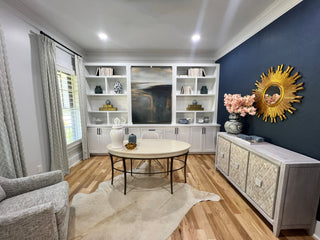In interior design, art possesses the unique ability to set the tone of a room and achieve balance, creating a remarkable impact on a space. In this article, award-winning interior designer and founder of Pineapple Park, Pacita Wilson, discusses the importance of art in design and how it grounds a room, sharing expert tips on art curation, proper scale, and installation.
How Art Enhances a Space
As an art lover, Pacita believes art is much more than a decorative element. In rooms filled with soft and hard case items, such as furniture, rugs, and lighting fixtures, art serves as a visual anchor that brings balance, a sense of grounding, harmony, symmetry, and cohesion to the space. While furniture provides structure to a room in a functional sense, art adds an additional layer of visual structure, or a bridge between design elements, by complementing or contrasting with the existing elements in the room. If you have a room with clean lines and minimalistic furniture, a bold and abstract painting can introduce a dynamic element, creating an interesting juxtaposition. On the other hand, if the room features ornate and intricate details, more subdued artwork can help create a harmonious balance.

Art’s ability to evoke emotions and add character sets the desired tone of a room. Whether it’s a bold abstract painting, a serene landscape, or a thought-provoking piece, the artwork will create a resultative vibe and influence a space’s mood. Bright and energetic pieces can infuse a room with vitality, while serene and contemplative art can induce a sense of tranquility. Pacita’s process for selecting art for a design project begins with getting to know her clients well. Art is curated to reflect each client’s essence and vision for their dream home. This emphasis adds a layer of uniqueness and personalization to a space, making it feel more intimate and inviting.

Why Bigger Is Better
Let’s delve into the impact of scale and why Pacita says bigger art is better! One of the most common decorating missteps is selecting art that is too small for a space. Smaller art has a tendency to get lost, create clutter, and in rooms with high ceilings or expansive walls, appear disproportionate. On the other hand, larger art creates a dramatic impact that leaves a lasting impression, fills the space more effectively, and creates a sense of harmony and proportion.
Also, when strategically placed, art can visually expand a room. Large-scale artwork establishes an illusion of depth and dimension. Pacita particularly loves how larger artwork can provide a sense of closeness and emotional connectedness in smaller rooms. She utilizes art to complement the colors and textures in the room, enhancing overall cohesiveness. So, don’t be afraid to think big when it comes to selecting art; go ahead and let it take center stage.

Using Mirrors as Artwork
Pacita recommends incorporating mirrors as artwork into an interior design as well. Mirrors can add visual impact to a room, create a sense of balance and symmetry, and help achieve a sense of equilibrium. With strategic placement, they can reflect light to enhance the perception of space and amplify other design features. Pacita loves incorporating mirrors of all sizes into her design projects.

How to Hang Your Art
There’s definitely an art to hanging artwork! An expert tip to keep in mind is to position the artwork’s center at eye level, which typically means hanging art so that the center of the piece is about 60 inches from the floor. Remember to consider any nearby furniture or architectural features. If hanging artwork above a sofa, it is recommended to leave a few inches of space between the top of the furniture and the bottom of the artwork for visual balance.

Learn More About Pineapple Park
By purposefully incorporating art and mirrors, one can transform a space while achieving stunning aesthetics, function, and atmosphere. Pacita loves how well-curated art creates connection and engagement, making design more meaningful for her clients. Pineapple Park is based in Georiga. To learn more, call Pineapple Park’s office at 678.401.4893 or email them here.


